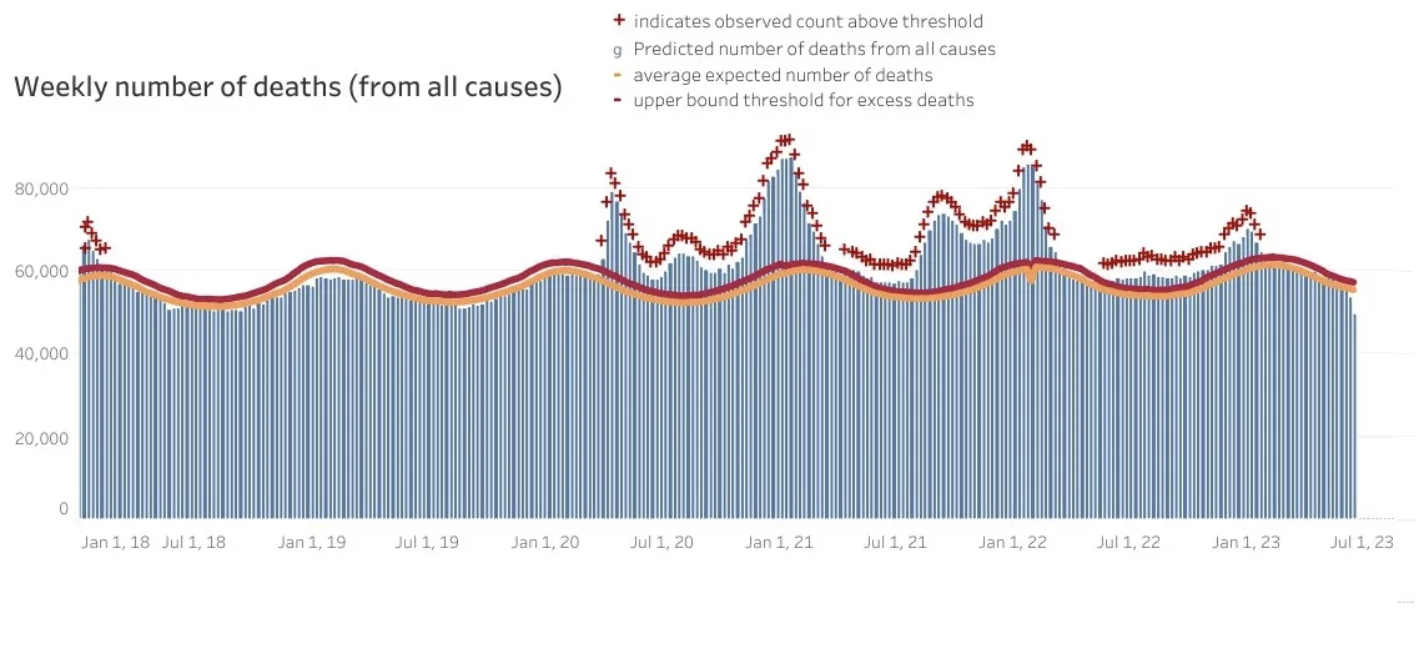Comments
- No comments found

Throughout the COVID pandemic, there have been controversies over whether certain deaths were really because of COVID, or were due to other causes.
After all, there’s a meaningful distinction between “dying because of COVID” and “dying with COVID.” There are other cases of deaths that occurred during the pandemic and because of the pandemic, but from causes like people whose chronic health conditions were not managed as well during the pandemic–perhaps because they were separated from their usual health care practitioners and from family and friends.
One way to sidestep many of these questions of categorization and classification is to just look at the total “excess deaths” in the US–that is, the number of deaths above the usual statistical prediction. The Centers for Disease Control publishes these figures, and here’s the most recent data.
The blue bars show actual reported deaths each week. The yellow curved line shows the pattern of deaths expected based on past experience, and the red line shows when the pattern of deaths is significantly higher than expected. The red plus signs show weeks when the number of deaths was significantly higher than expected–that is, above the red line.

It’s useful to note here that the pattern of deaths is somewhat seasonal, tending to rise each winter. There are also times in the past that reported excess deaths like the flu outbreak in early 2018 shown in the far right of the figure.
The COVID pandemic is obvious in the figure. There was one previous time, early in 2022, when it looked for a few weeks as if the level of excess deaths might have fallen back to zero, but it didn’t last. However, the number of excess deaths has now been below zero since mid-January 2023. (As the CDC warns, the bars showing deaths for the past few weeks are underestimated, because it takes some time for deaths to be fully reported to the national database.)
Yes, the “excess deaths” measure will mix together those who died 100% of COVID, those for whom COVID exacerbated a pre-existing condition, and those who died during the pandemic because of conditions created by the pandemic, but not because they contracted the novel coronavirus. The epidemiologists and public health authorities will be sorting out these categories in research yet to come. Of course, we’ll have to see what happens this fall and winter. But for now, the bottom line seems to be that excess deaths have gone to zero for the last six months and the COVID pandemic is over in the United States.
Timothy Taylor is an American economist. He is managing editor of the Journal of Economic Perspectives, a quarterly academic journal produced at Macalester College and published by the American Economic Association. Taylor received his Bachelor of Arts degree from Haverford College and a master's degree in economics from Stanford University. At Stanford, he was winner of the award for excellent teaching in a large class (more than 30 students) given by the Associated Students of Stanford University. At Minnesota, he was named a Distinguished Lecturer by the Department of Economics and voted Teacher of the Year by the master's degree students at the Hubert H. Humphrey Institute of Public Affairs. Taylor has been a guest speaker for groups of teachers of high school economics, visiting diplomats from eastern Europe, talk-radio shows, and community groups. From 1989 to 1997, Professor Taylor wrote an economics opinion column for the San Jose Mercury-News. He has published multiple lectures on economics through The Teaching Company. With Rudolph Penner and Isabel Sawhill, he is co-author of Updating America's Social Contract (2000), whose first chapter provided an early radical centrist perspective, "An Agenda for the Radical Middle". Taylor is also the author of The Instant Economist: Everything You Need to Know About How the Economy Works, published by the Penguin Group in 2012. The fourth edition of Taylor's Principles of Economics textbook was published by Textbook Media in 2017.
Leave your comments
Post comment as a guest